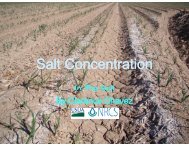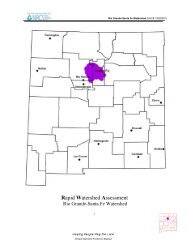SAMPLING VEGETATION ATTRIBUTES - New Mexico NRCS - US ...
SAMPLING VEGETATION ATTRIBUTES - New Mexico NRCS - US ...
SAMPLING VEGETATION ATTRIBUTES - New Mexico NRCS - US ...
You also want an ePaper? Increase the reach of your titles
YUMPU automatically turns print PDFs into web optimized ePapers that Google loves.
28<br />
<strong>ATTRIBUTES</strong><br />
b Standing crop and peak standing crop are the measurements most often used in<br />
trend studies. Peak standing crop is generally measured at the end of the growing<br />
season. However, different species reach their peak standing crop at different<br />
times. This can be a significant problem in mixed plant communities.<br />
c Often, the greater the diversity of plant species or growth patterns, the larger<br />
the error if only one measurement is made.<br />
d Other problems associated with the use of plant biomass are that fluctuations in<br />
climate and biotic influences can alter the estimates. When dealing with large<br />
ungulates, exclosures are generally required to measure this parameter. Several<br />
authors have suggested that approximately 25% of the peak standing crop is<br />
consumed by insects or trampled; this is rarely discussed in most trend studies.<br />
e Collecting production data also tends to be time and labor intensive. Cover and<br />
frequency have been used to estimate plant biomass in some species.<br />
E. Structure<br />
1. Description Structure of vegetation primarily looks at how the vegetation is<br />
arranged in a three-dimensional space. The primary use for structure measurements<br />
is to help evaluate a vegetation community’s value in providing habitat for<br />
associated wildlife species.<br />
Vegetation is measured in layers on vertical planes. Measurements generally look<br />
at the vertical distribution by either estimating the cover of each layer or by<br />
measuring the height of the vegetation.<br />
2. Advantages and Limitations Structure data provide information that is<br />
useful in describing the suitability of the sites for screening and escape cover,<br />
which are important for wildlife. Methods used to collect these data are quick,<br />
allowing for numerous samples to be obtained over relatively large areas. Methods<br />
that use visual obstruction techniques to evaluate vegetation height have little<br />
observer bias. Those techniques that estimate cover require more training to<br />
reduce observer bias. Structure is rarely used by itself when describing trend.<br />
F. Composition<br />
1. Description Composition is a calculated attribute rather than one that is directly<br />
collected in the field. It is the proportion of various plant species in relation to the<br />
total of a given area. It may be expressed in terms of relative cover, relative density,<br />
relative weight, etc.<br />
Composition has been used extensively to describe ecological sites and to evaluate<br />
rangeland condition.<br />
To calculate composition, the individual value (weight, density, percent cover) for<br />
a species or group of species is divided by the total value of the entire population.




